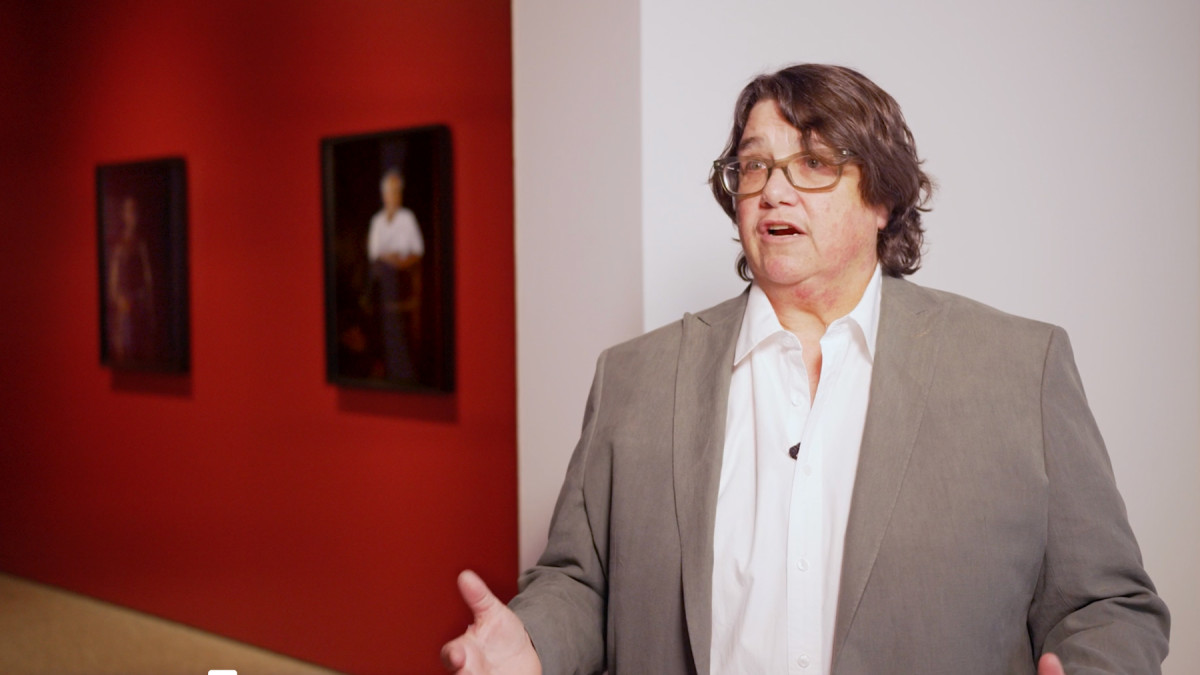Frontier-Linear
2009 - Film & Video (Film & Video)
Doug Aitken
The version of Frontier acquired by the Kadist Collection consists of a single-channel video, adapted from the monumental installation and performance that Aitken presented in Rome, by the Tiber River, in 2009. In this film, Aiken’s allusion to “the frontier” and iconic imagery like the cowboy suggest that the American West Coast as a cultural construction. These notions are reinforced by two key elements in the film: its protagonist, the iconic West Coast artist Ed Ruscha, and its reference to the cinematic and the experience of the movie theater. The film is structured as a journey in time, from day to night. The completed film was shot in different places around the globe, including Los Angeles, Rome, South Africa, and Israel, which suggests the blurring boundaries of the unknown and emphasizes both fictive and real landscapes.
Doug Aitken’s work started to draw international attention when his installation Electric Earth earned the International Prize at the 1999 Venice Biennale, which was organized by renowned Swiss curator Harald Szeemann. Interested in breaking conventional narratives, Aitken emphasizes circularity and non-linearity in his monumental site-specific installations. This monumentality is usually expressed in Aitken’s tendency to combine apparently disconnected fragments in order to create epic films. Although this aspect of his work differs from the all-encompassing wholes sought by modernism, Aitken’s films play with the imaginary and surreal in a way that flirts with the notion of utopia. The artist uses pop culture and, especially, the film industry as sources for his compelling and immersive environments. Aesthetic elements such as coloration, light and space and a careful editing process give his films a contemplative mood.
Colors:
Other related works, blended automatically

© » KADIST
Cerith Wyn Evans
2008Untitled (Perfect Lovers + 1) by Cerith Wyn Evans takes as its starting point Felix Gonzales-Torres’s seminal work Untitled (Perfect Lovers) , in which two clocks were synchronized and left to run without interference, the implication being that one would stop before the other...

© » KADIST
Lynn Hershman Leeson
2017Using the seminal 1958 film Vertigo as a launchpad, Lynn Hershman Leeson explores the blurred lines between fact and fantasy in VertiGhost , a film commissioned by the Fine Arts Museums in San Francisco...

© » KADIST
Du Zhenjun
2010The Tower of Babel is an installation of large-format photographs that forces the audience to occupy a central position through its monumental scale...

© » KADIST
Catherine Opie
1994Although best known as a provocateur and portraitist, Opie also photographs landscapes, cityscapes, and architecture...

© » KADIST
Nalini Malani
2012Malani draws upon her personal experience of the violent legacy of colonialism and de-colonization in India in this personal narrative that was shown as a colossal six channel video installation at dOCUMENTA (13), but is here adapted to single channel...

© » ROYAL ACADEMY
Catherine Opie
Video: Catherine Opie on photographing leading British artists | Blog | Royal Academy of Arts Catherine Opie in the RA Collection Gallery Video: Catherine Opie on photographing leading British artists Read more Become a Friend Video: Catherine Opie on photographing leading British artists Published 8 September 2023 Catherine Opie discusses her portraits of David Hockney, Anish Kapoor, Gillian Wearing, Isaac Julien and Lynette Yiadom-Boakye, featured in our free display in the Collection Gallery...

© » KADIST
Walead Beshty
2018Office Work by Walead Beshty consists of a partially deconstructed desktop monitor screen, cleanly speared through its center onto a metal pole...

© » KADIST
Catherine Opie
1987In this work, a woman sits on a couch with her shirt pulled up to expose her pierced nipples, which are connected by a chain...

© » KADIST
Rodney Graham
1991Ponderosa Pine IV belongs to a series of large-scale photographs of trees taken by Graham and depicts a particular species that live in Northern California...

© » KADIST
Nalini Malani
1996Memory: Record/Erase is a stop-motion animation by Nalini Malani based on ‘The Job,’ a short story by celebrated German poet and playwright Bertolt Brecht...

© » KADIST
Gimhongsok
2007To explore the boundaries between artwork and audience, Gimhongsok created a series of sculptural performances in which a person wearing an animal costume poses in the gallery...

© » KADIST
Mauricio Ancalmo
2010War Footage is a series of wall-mounted works composed of 16mm film leader, tightly bound to flag-shaped panels by the artist...

© » KADIST
Yoshua Okón
2015Fridge-Freezer is a 2-channel video installation where Yoshua Okón explores the darker side of suburbia, d escribed by the artist as “ the ideal environment for a numb existence of passive consumerism and social a nd environmental disengagement...







